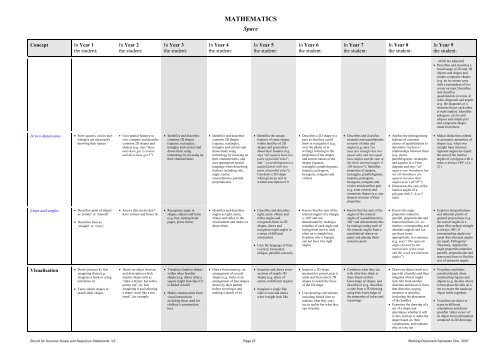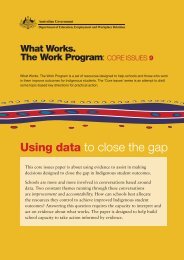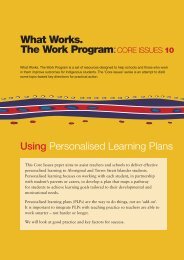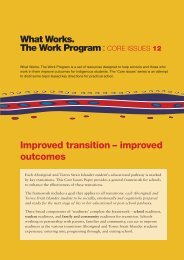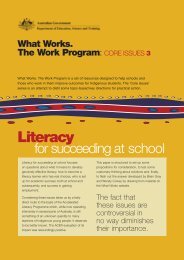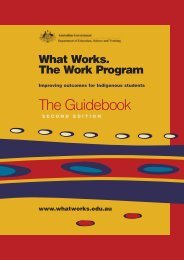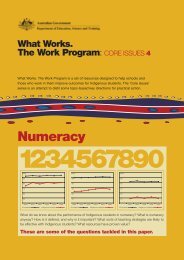MATHEMATICSSpaceConcept In Year 1the student:In Year 2the student:In Year 3the student:In Year 4the student:In Year 5the student:In Year 6the student:In Year 7the student:In Year 8the student:In Year 9the student:which are adjacent)• Describes <strong>and</strong> classifies abroad range of 2D <strong>and</strong> 3Dobjects <strong>and</strong> shapes <strong>and</strong>simple composite shapes(e.g. an ice-cream conewith a hemisphere of icecreamon top); Describes<strong>and</strong> classifiesquadrilaterals in terms ofsides, diagonals <strong>and</strong> angles(e.g. the diagonals of arhombus bisect each otherat right angles); Identifiespolygons, circles <strong>and</strong>ellipses <strong>and</strong> simple part<strong>and</strong> composite shapesmade from theseIn two dimensions• Sorts squares, circles <strong>and</strong>triangles not necessarilyknowing their names• Uses spatial features tosort, compare <strong>and</strong> describecommon 2D shapes <strong>and</strong>objects (e.g. says “theseones have got 3 corners<strong>and</strong> these have got 5”)• Identifies <strong>and</strong> describescommon 2D shapes(squares, rectangles,triangles <strong>and</strong> circles) <strong>and</strong>draws them usingtechnology by focusing ontheir characteristics• Identifies <strong>and</strong> describescommon 2D shapes(squares, rectangles,triangles <strong>and</strong> circles) <strong>and</strong>draws them usingtechnology by focusing ontheir characteristics, <strong>and</strong>uses appropriate spatiallanguage when describingfeatures including side,angle, centre,circumference, parallel,perpendicular• Identifies the uniquefeatures of some shapeswithin families of 2Dshapes <strong>and</strong> generalisesabout their features (e.g.says “all squares have twopairs of parallel sides”,<strong>and</strong> “ a parallelogram is aquadrilateral with twopairs of parallel sides”);Can draw a 2D shapewhen given an oral orwritten description of it• Describes a 2D shape to apeer so that they coulddraw or recognise it (e.g.over the phone or inwriting) referring to theproperties of the shapes<strong>and</strong> correct names of theshapes (squares,rectangles, parallelograms,trapezia, pentagons,hexagons, octagons <strong>and</strong>circles)• Describes <strong>and</strong> classifiestriangles <strong>and</strong> quadrilateralsin terms of sides <strong>and</strong>angles (e.g. says “anisosceles triangle has twoequal sides <strong>and</strong> two equalbase angles <strong>and</strong> the sum ofthe three internal angles is180 degrees”); Identifiesproperties of squares,rectangles, parallelograms,trapezia, pentagons,hexagons, octagons <strong>and</strong>circles <strong>and</strong> describes part(e.g. semi-circles) <strong>and</strong>composite shapes (e.g. starshapes) in terms of theirproperties• Applies the distinguishingfeatures of commonclasses of quadrilaterals todetermine ‘inclusive’relationships between them(e.g. showsparallelograms, rectangles<strong>and</strong> squares in a Venndiagram <strong>and</strong> says “allsquares are rhombuses butnot all rhombuses aresquares because theirangles aren’t all 90°”)• Determines the sum of theinterior angles of apolygon with 3, 4, or 5sides• Makes deductions relatedto geometric properties ofshapes (e.g. when twostraight lines intersect,opposite angles are equal;the sum of the interiorangles of a polygon with nsides is always 180° x [n -2] )Lines <strong>and</strong> angles• Describes parts of shapesas ‘pointy’ or ‘smooth’• Describes lines as‘straight’ or ‘curvy’• Knows that circles don’thave corners <strong>and</strong> boxes do• Recognises angle inshapes, objects <strong>and</strong> turns(e.g. box, turning bookpages, pizza slices)• Identifies <strong>and</strong> describesangles as right, acute,obtuse <strong>and</strong> reflex in theenvironment <strong>and</strong> makes ordraws them• Classifies <strong>and</strong> describesright, acute, obtuse <strong>and</strong>reflex angles <strong>and</strong>recognises them in 2Dshapes; draws <strong>and</strong>recognises right angles ina range of differentorientations• Uses the language of lines(vertical, horizontal,oblique, parallel) correctly• Knows that the sum of theinternal angles of a triangleis 180º <strong>and</strong> c<strong>and</strong>emonstrate by making atemplate of each angle <strong>and</strong>laying them next to eachother on a straight line;Explains why a trianglecan not have two rightangles• Knows that the sum of theangles of the internalangles of a quadrilateral is360° <strong>and</strong> demonstrates thisby tearing/cutting each ofthe internal angles from aquadrilateral drawn onpaper <strong>and</strong> placing themaround a point• Knows the angleproperties related toparallel, perpendicular <strong>and</strong>transversal lines (i.e. cointerior,corresponding <strong>and</strong>alternate angles) <strong>and</strong> canuse these termsappropriately in a sentence(e.g. says “ The oppositeangles <strong>for</strong>med by theintersection of the road<strong>and</strong> the creek are alternateangles”)• Explores demonstrations<strong>and</strong> in<strong>for</strong>mal proofs ofgeneral propositions (e.g.the sum of angles in aplane (flat surface) triangleis always 180°; ifcorresponding angles areequal then alternate anglesare equal, Pythagoras’Theorem); Applies theangle properties related toparallel, perpendicular <strong>and</strong>transversal lines to find thesize of unknown anglesVisualisation• Draws pictures by firstimagining them (e.g.imagines a book or a dog<strong>and</strong> draws it)• Turns simple shapes tomatch other shapes• Draws an object from anoral description whichimplies shape such as“draw a skinny hat with apointy top”, by firstimagining it <strong>and</strong> selectinga shape ‘most like a treetrunk’, <strong>for</strong> example• Visualises familiar shapeswithin other familiarshapes (e.g. draws what asquare might look like if itis folded in half)• Makes constructions fromvisual instructionsincluding those used <strong>for</strong>children’s constructiontoys• Draws from memory, anarrangement of severalshapes (e.g. looks at anarrangement of four shapesdrawn by their partnerbe<strong>for</strong>e covering it <strong>and</strong>making a sketch of it)• Imagines <strong>and</strong> draws crosssectionsof simple 3Dshapes (e.g. slices ofcarrots at different angles)• Imagines a single flip,slide or turn <strong>and</strong> drawswhat it might look like• Inspects a 3D shape(pyramid or prism), puts itaside <strong>and</strong> then selects 2Dshapes to match the facesof the 3D shape• Uses drawing conventionsincluding dotted lines toindicate what they can’tsee in reality but what theycan visualise• Combines what they seewith what they think isthere based on theirknowledge of shapes, <strong>and</strong>describes it (e.g. describesa cube from a 3D drawingusing their knowledge ofthe properties of cubes <strong>and</strong>reasoning)• Draws an object (such as ajug with a h<strong>and</strong>le) <strong>and</strong> thenimagines what it mightlook like from anotherdirection <strong>and</strong> draws it fromthat direction, payingattention to specifics(including the placementof the h<strong>and</strong>le)• Examines the drawing of anet of a shape <strong>and</strong>determines whether it willin fact, fold up to make theshape based on theirvisualisation, <strong>and</strong> explainswhy or why not• Visualises <strong>and</strong> plansessential details whenconstructing figures <strong>and</strong>objects (e.g. decides whereto best place the tabs on anet to ensure the made-upobject holds together)• Visualises an object orscene in differentorientations <strong>and</strong> drawspossible ‘other views’ ofan object from in<strong>for</strong>mationcontained in 2D drawings<strong>Bound</strong> <strong>for</strong> <strong>Success</strong> <strong>Scope</strong> <strong>and</strong> <strong>Sequence</strong> <strong>Statements</strong> V2 Page 27 Working Document Semester One 2007
MATHEMATICSSpaceConcept In Year 1the student:In Year 2the student:In Year 3the student:In Year 4the student:In Year 5the student:In Year 6the student:In Year 7the student:In Year 8the student:In Year 9the student:Symmetry <strong>and</strong>Trans<strong>for</strong>mationsMathematicallytrans<strong>for</strong>ming shapes<strong>and</strong> objects assists inunderst<strong>and</strong>ing pattern<strong>and</strong> design in thenatural <strong>and</strong> builtenvironment• Folds shapes that have linesymmetry across the lineof symmetry so that oneside fits exactly onto theother• Knows what linesymmetry is <strong>and</strong> foldsshapes along the ‘line ofsymmetry’ when directedto• Recognises line symmetryin nature (e.g. butterflies,faces) <strong>and</strong> uses mirrors <strong>and</strong>folding to explore <strong>and</strong>identify symmetry in avariety of shapes; uses theword ‘symmetry’appropriately in a sentence(e.g. says “this shape hasline symmetry <strong>and</strong> this onedoesn’t”)• Uses mirrors <strong>and</strong> foldingto show why some shapesare not symmetrical abouta given line(asymmetrical)• Identifies symmetricalshapes <strong>and</strong> designs, createssome usingtrans<strong>for</strong>mations (e.g. flips)<strong>and</strong> explains why othersare not symmetrical(asymmetrical)• Decides whether arotation, reflection, ortranslation is involved inproducing a symmetricalarrangement <strong>and</strong> describesit using spatial language(e.g. says “the logo <strong>for</strong> thatbusiness is based on atriangle that is repeatedthree times <strong>and</strong> then fitsback on itself <strong>and</strong> so it hasrotational symmetry”)• Identifies lines ofsymmetry <strong>for</strong> 2D shapesusing mirror lines, <strong>and</strong>identifies points <strong>and</strong> anglesof rotational symmetry(e.g. says “a snowflake (orpentagon) has a point ofcentral rotation <strong>and</strong> anangle of rotation of 72degrees about the point”);Identifies lines <strong>and</strong> planesof symmetry <strong>for</strong> 3Dobjects <strong>and</strong> tests whether2D <strong>and</strong> 3D shapes aresymmetrical; Appliessymmetry to construct 2D<strong>and</strong> 3D shapes using paperfolding <strong>and</strong>/ortechnological drawingsoftware• Uses an appropriate grid toproduce a specifiedsymmetrical shape (e.g.uses circular grid paper orcomputer graphics torotate a given figure tomake a design which hasrotational symmetry, <strong>and</strong>which is rotated six timesto get back to where itstarted; Uses square gridpaper or computergraphics to reflect a shapeacross a line of symmetryto create a shape that hasfour internal squaresastride the line ofsymmetry)• Demonstrates flips, slides<strong>and</strong> turns using materialsincluding pattern blocks• Identifies when flips,slides <strong>and</strong> turns have beenused to change the positionof 2D <strong>and</strong> 3D shapes (e.g.says “that shape has beenturned around <strong>and</strong> thatone has been pushedalong”)• Explores <strong>and</strong> describes theeffect of a single flip, slideor turn on different shapes(e.g. says “if you turn thatone around in a full circleit comes back on itself”<strong>and</strong> “if you flip that shapeit points the other way”)• Explores <strong>and</strong> describes theeffect of multiple/consecutive flips, slides orturns one after the other ondifferent shapes <strong>and</strong> talksabout their results usingappropriate mathematicalterms (e.g. says “If youturn that shape around ina half circle <strong>and</strong> then flipit, it comes back to whereit was at first”)• Describes the result ofcombinations oftrans<strong>for</strong>mations on a shape(e.g. a slide then a turn)<strong>and</strong> creates patterns <strong>and</strong>designs using thesecombinations• Knows that two shapes arecongruent if one flips,slides or turns (or acombination of these)exactly onto another;Knows that if it foldsexactly onto itself over amirror line then it issymmetrical <strong>and</strong> that theoriginal shape <strong>and</strong> itsimage are congruent <strong>and</strong>has a line of symmetry,<strong>and</strong> can explain <strong>and</strong> showwhy using an example• Recognises symmetry <strong>and</strong>congruence <strong>and</strong> relatesthese to trans<strong>for</strong>mations<strong>and</strong> patterns involvingshapes in the plane, <strong>and</strong>describes theserelationships using correctterminology (e.g. says “allof the triangles in thatborder pattern arecongruent <strong>and</strong> the next onealong is found by rotatingthe one be<strong>for</strong>e it ninetydegrees”)• Determines when twotriangles are similar orcongruent using theproperties of similarity orcongruency• Uses congruent <strong>and</strong> similartriangles to solvegeometric problemsinvolving patterns <strong>and</strong>design• Creates a continuouspattern using a translationby drawing (by h<strong>and</strong> orwith technology) or usingmaterials including patternblocks• Predicts <strong>and</strong> draws (orpositions using objects)what the next position <strong>and</strong>orientation will look like ina border pattern• Uses symmetry <strong>and</strong>/ortrans<strong>for</strong>mations to createor continue patterns,including tessellations• Knows <strong>and</strong> underst<strong>and</strong>sthat a tessellation is madeby a complete covering ofa surface by one or moreshapes in a repeatedpattern so that there are nogaps or overlaps, <strong>and</strong> canrecognise <strong>and</strong> explainwhether a pattern is atessellation or not• Uses multiple copies ofdifferent shapes to observethat some shapes willalways tessellate (e.g.triangles <strong>and</strong>quadrilaterals) <strong>and</strong> somewon’t (e.g. pentagons)• Uses single congruent,regular shapes to producetessellations on a flatsurface (e.g. makes/drawsa brick pattern <strong>for</strong> paving)• Uses two regular shapes toproduce a tessellation on aflat surface (e.g.makes/draws a brickpattern <strong>for</strong> paving) byusing one different shapethat fits inside another anumber of times with nooverlaps including asquare <strong>and</strong> the twotriangles thatsymmetrically fit inside it)• Uses trans<strong>for</strong>mations tomodify tessellating shapesto produce othertessellating shapes, <strong>and</strong>in<strong>for</strong>mally explains whythey do or don’t work (e.g.a tessellation using squarescan be modified to <strong>for</strong>m an‘’Escher-type’ design byoutwardly extending oneside <strong>and</strong> inwardlyextending the opposite sidethe same way; says “thisshape won’t tessellatebecause if you translatethis side onto the oppositeside it’s not exactly thesame”)MapsMaps help locateplaces <strong>and</strong> objects infamiliar <strong>and</strong>unfamiliarenvironments• Uses appropriate languageof position (e.g. next to,behind, below, above) insimple sentences• Uses positional language(e.g. to the right of,between) <strong>and</strong> referencepoints or l<strong>and</strong>marks todescribe locations,arrangements <strong>and</strong>pathways (e.g. says “allthe shops are in a row”<strong>and</strong> “the school is betweenthe post office <strong>and</strong> thepolice station”)• Identifies key features onsimple maps, grids <strong>and</strong>plans (e.g. says “that is thetoilets <strong>and</strong> this block hereis the classrooms”)• Interprets <strong>and</strong> developssimple keys/legends <strong>for</strong>their own maps <strong>and</strong> mapsof peers, of familiar <strong>and</strong>local locations• Interprets <strong>and</strong> usessymbols (e.g. the northsymbol <strong>and</strong> thekey/legend) <strong>and</strong>conventions (e.g. A6 ongrids) when planningdirections or placement offeatures on maps, <strong>and</strong>when reading a map• Holds a map with the northpoint in front of them <strong>and</strong>can determine whether toturn left or right in real lifebased on the position onthe map• Provides <strong>and</strong> followsinstructions <strong>for</strong> movingfrom one location toanother based on plans <strong>and</strong>maps referring to distance,left <strong>and</strong> right, <strong>and</strong> angles indegrees (e.g. says “to getto the shop go down thisroad about two hundredmetres, <strong>and</strong> turn left” <strong>and</strong>“go straight <strong>and</strong> then turnto the right <strong>for</strong>ty-fivedegrees”)• Follows <strong>and</strong> givesdirections <strong>for</strong> locationsusing coordinates (e.g.using a street directoryplans the shortest distancefrom a house at B4 to thebeach at H12; Programs acomputer to generate aspecified shape (e.g. arectangle) using theproperties of the shape• Provides directions fromone location to another ona variety of maps <strong>and</strong> planswith reference to keyfeatures, distance <strong>and</strong>orientation, calculatingapproximate distance fromscales (e.g. when planninga family holiday throughcentral Australia says “thescale on the map in theatlas says 1:1000 so to getto Alice Springs from herewe will need to drive about<strong>Bound</strong> <strong>for</strong> <strong>Success</strong> <strong>Scope</strong> <strong>and</strong> <strong>Sequence</strong> <strong>Statements</strong> V2 Page 28 Working Document Semester One 2007


